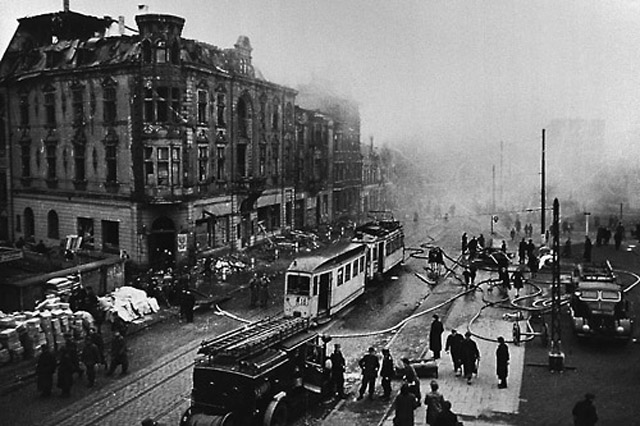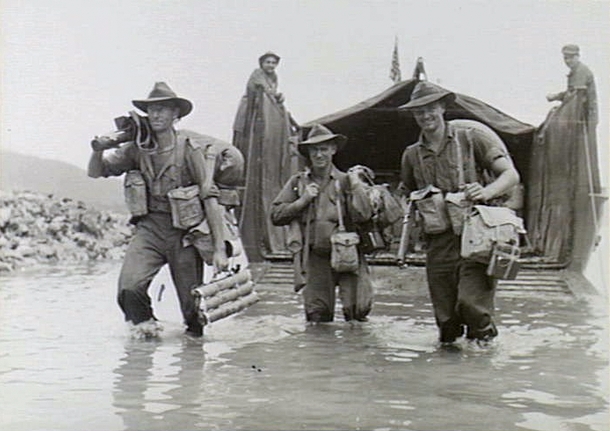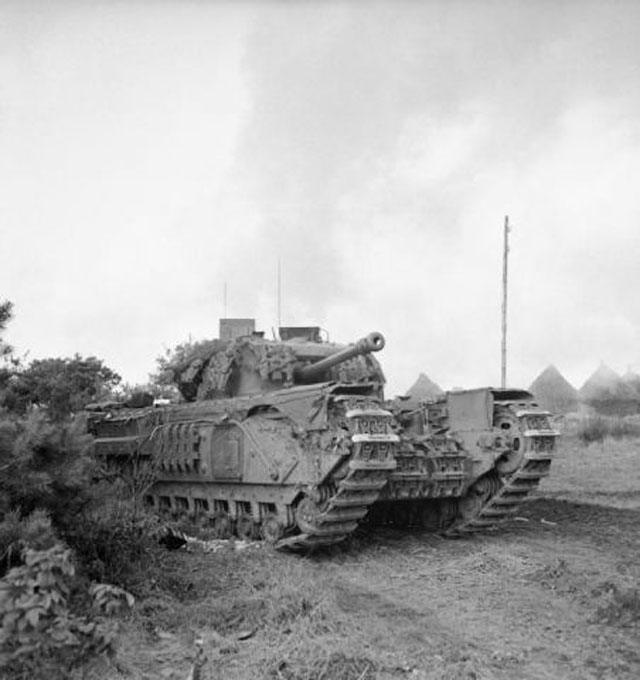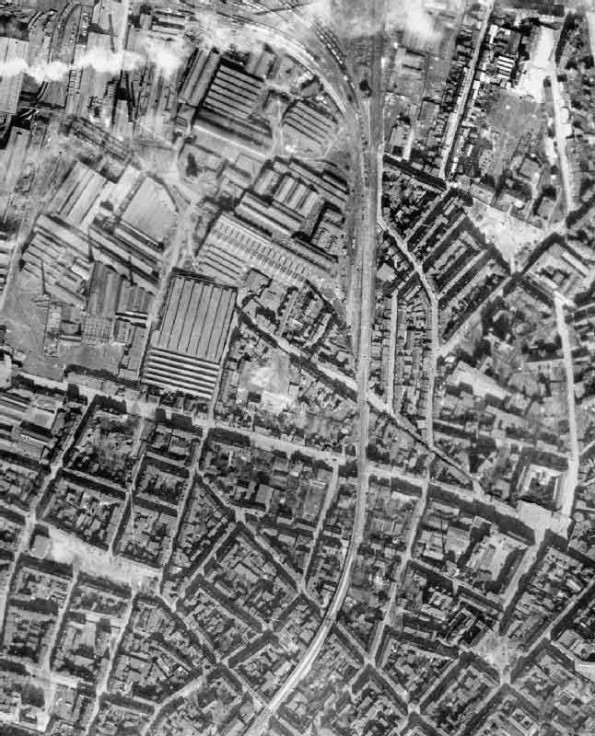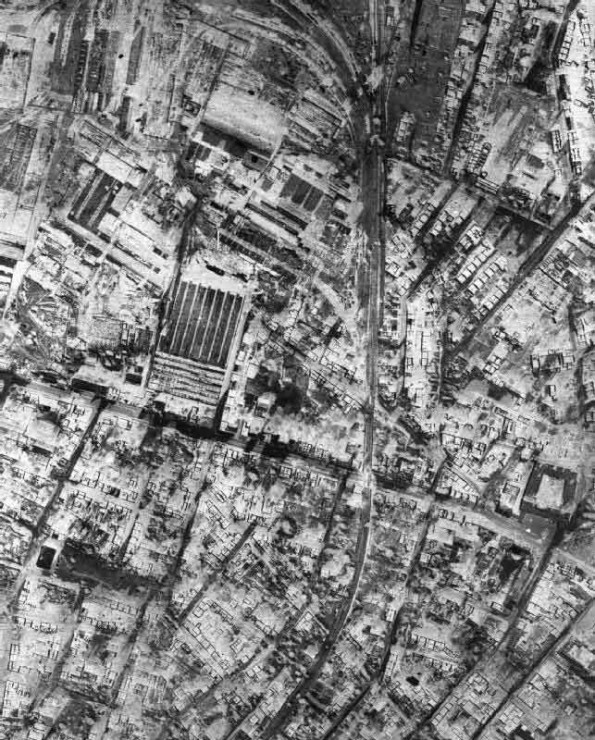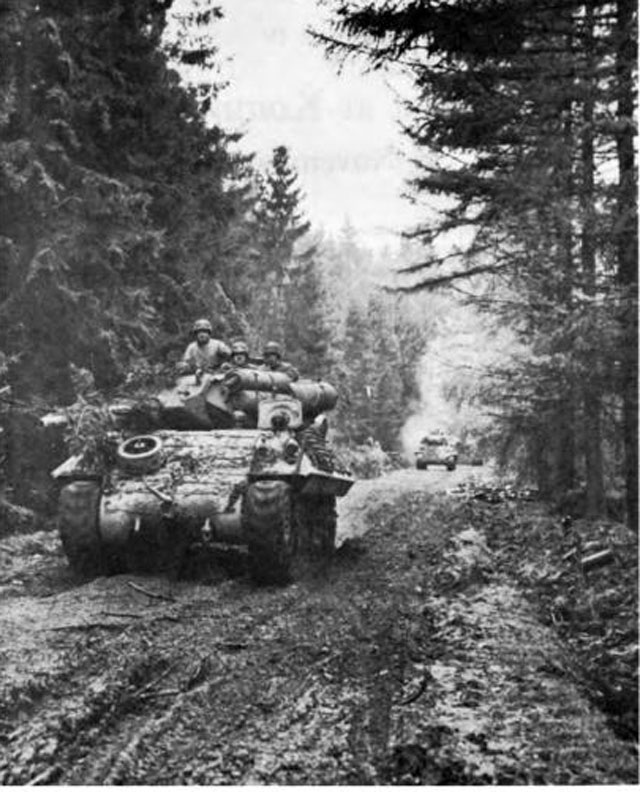Air Operations, Bonin and Volcano Islands
18 11th Heavy Bomb Group B-24s attack Iwo Jima, and two B-24s attack Haha Jima.
[Air Operations, Carolines
VMTB-232 TBMs based at the Falalop airfield on Ulithi mount their first bombing attack against the airfield on Yap.
[Air Operations, CBI
BURMA- 17 10th Air Force P-47s attack the airfield at Shwebo.
- 6 P-47s attack artillery and ammunition stores at Mong Yaw.
- A 2nd Air Commando Group P-47 downs a Ki-44 'Tojo' fighter over Rangoon at an unspecified time.
- 459th Fighter Squadron P-38s down 1 Ki-44 'Tojo' fighter and 1 Ki-43 'Oscar' fighters near Insein between 1135 hours and noon.
- 34 14th Air Force fighter-bombers attack road traffic and targets of opportunity around Lungling and Mangshih.
- 4 459th Fighter Squadron P-38s attack a pass at Mengshu.
Air Operations, Europe
Allied bombers are now over German cities day and night. During the day over 1,100 American Fortresses and Liberators bomb targets in the areas of Hamburg, Hanover and Saarbrücken. At night the RAF bombs targets in the Ruhr with over 1,000 bombers.
RAF BOMBER COMMANDDaylight Ops:
- 176 Lancasters of No. 3 Group are sent to Solingen. It is not a successful raid and the bombing is badly scattered.
- 4 Lancasters are lost.
- 2 Wellingtons and 1 Halifax fly RCM sorties.
- 749 aircraft of Nos 1, 4, 6 and 8 Groups are sent to Bochum. In the aircraft total are 384 Halifaxes, 336 Lancasters and 29 Mosquitos. This is a particularly successful attack based upon standard Pathfinder marking techniques. Severe damage is caused to the center of Bochum. More than 4,000 buildings are destroyed or seriously damaged. Bochum's industrial areas are also severely damaged, particularly the important steelworks. This was the last major raid by Bomber Command on this target.
- 23 Halifaxes and 5 Lancasters are lost. German night fighters cause most of the casualties. No. 346 (Free French) Squadron, based at Elvington, loses 5 out of its 16 Halifaxes on the raid.
- 174 Lancasters and 2 Mosquitos of No. 5 Group are sent to hit the Dortmund-Ems Canal. The Germans had partly repaired the section of the canal north of Münster after the No. 5 Group raid in September, so this further attack is required. The banks of both branches of the canal are again breached and water drains off, leaving barges stranded and the canal unusable. A report from Speer to Hitler, dated November 11, 1944, that was captured at the end of the war, describes how the bombing of the canal was preventing smelting coke from the Ruhr mines reaching 3 important steelworks, 2 near Brunswick and 1 at Osnabrück. In his post-war interrogation, Speer stated that these raids on the Dortmund-Ems Canal, together with attacks on the German railway system, produced more serious setbacks to the German war industry at this time than any other type of bombing.
- 3 Lancasters are lost.
- 43 Mosquitos are sent to Hannover and 6 to Herford, and there are 68 Mosquito patrols and 39 RCM sorties. No. 100 Group Mosquitos claim 4 Ju-88s and 2 Me-110s destroys and 2 other night fighters damages, possibly their most successful night of the war.
GERMANY:
- 238 1st Bomb Division B-17s attack an oil-industry target at Hamburg.
- 91 1st Bomb Division B-17s attack an oil-industry target at Bottrop.
- 210 2nd Bomb Division B-24s attack an oil-industry target at Hannover.
- 133 2nd Bomb Division B-24s attack an oil-industry target at Gelsenkirchen.
- 186 3rd Bomb Division B-17s attack an oil-industry target at Hamburg.
- 151 3rd Bomb Division B-17s attack an oil-industry target at Neunkirchen.
- 87 B-17s attack various secondary targets (three marshalling yards) and targets of opportunity.
- 5 heavy bombers and 2 of 768 VIII Fighter Command escorts are lost.
GERMANY:
- A total of 218 9th Bomb Division B-26s and A-20s attack gun emplacements around Eschweiler, a depot at Baumholder, and an ordnance depot at Trier.
- 9th Air Force fighter-bombers attack bridges and rail lines, and support US Army ground forces around Aachen.
ITALY:
- More than 200 12th Air Force B-25s and B-26s attack road and rail bridges leading from Brenner Pass.
- More than 130 B-25s attack communications targets and bridges in the Po River valley.
- XXII TAC P-47s attack trains and other communications targets in the Po River valley, and gun emplacements, rocket sites, and communications targets in and around the battle area.
- 4 P-47s bomb a hotel in Milan at which Adolf Hitler is erroneously rumored to be staying.
AUSTRIA:
- 15th Air Force B-24s attack a marshalling yard and a synthetic-oil plant at Linz.
- 15th Air Force B-17s and B-24s attack marshalling yards at Augsburg and Munich.
- B-17s attack oil storage facilities at Regensburg.
- 15th Air Force heavy bombers attack a German Army troop concentration at Podgorica.
Air Operations, Japan
6 28th Composite Bomb Group B-24s attack Kurabu and Suribachi in the Kurile Islands.
[Air Operations, Philippines
- 35 Japanese aircraft mount a successful low-level attack against the Tacloban airfield on Leyte. 4 US servicemen are killed and 39 are wounded, 2 P-38s are destroyed, and 39 P-38s are damaged. Also, 2 kamikazes crash into 2o US Navy transports carrying ground personnel from the 345th Medium Bomb Group to the Tacloban airfield Leyte. 107 US servicemen are killed and 141 are injured in this incident.
- FEAF B-24s attack the Alicante airfield on Negros.
- A 49th Fighter Group P-38 downs an A6M Zero over Leyte at 0750 hours.
- 8th Fighter Group P-38s down 6 Japanese fighters near the Alicante airfield on Negros at 1050 hours.
Britain, Command
Gen Sir John Dill, head of the British Chiefs of Staff Mission in Washington, dies at the age of 63. He was chief of the British Military Mission in Washington and a member of the Combined Chiefs of Staff, representing the British Chiefs of Staff officially and Prime Minister Churchill unofficially. His close friendship with Chief of Staff George C. Marshall (USA) has been instrumental in smoothing over American and British divergence over strategic issues from 1942 to 1944.
[Burma
In the northwest of the country, in the 14th Army's advance the 5th Indian Div of the XXXIII Corps takes Kennedy Peak, another Japanese strongpoint south of Tiddim.
[Eastern Front
In Hungary, southeast of Budapest Szolnok, on the railway between Debrecen and Budapest, falls to the troops of the 2nd Ukraine front. They then push on to Cegled only 40 miles from the capital. Long range guns begin bombarding Budapest. Heavy rain and growing resistance by the Germans and Hungarians have almost halted the Russians' offensive thrust. In Dalamtia Sebenico is taken by the partisans.
SOUTHERN SECTORThe 46th Army penetrates into the suburbs of Budapest but can do no more. Lead elements of the Soviet spearhead are threatened by 2 counterattacking panzer divisions (the 1st and 3rd). The Germans have, in the first few days of November, deployed the III Panzer Corps before the city, the IV Panzer Corps at Jaszbereny and the LVII Panzer Corps around Cegled and Szolnok. The 7th Guards Army takes Cegled and Szolnok as it lags some way behind the 46th. In Dalmatia, Tito captures Sebenico.
[Italy
The South African 6th Arm Div comes under the command of the IV Corps, US 5th Army; until now it has been directly under Army command.
[Pacific
- The US submarines Bream (SS-243), Guitarro (SS-363) and Ray (SS-271) attack a Japanese convoy off western Luzon and sink the transport Kagu Maru (6806t) off Dasol Bay.
- The British submarine Terrapin attacks a Japanese convoy in Malacca Strait and sinks the minewsweeper W-5.
Philippines
On Leyte for fear of a Japanese counterattack by sea, the X Corps is ordered to re-group and take up defensive positions in the Carigara area, in the north of the island. Elements of the X Corps will have to advance toward Ormoc and select positions that can be used as gun emplacements to shell the big enemy base. In the XXIV Corps sector, units of the US 96th Inf Div renew their attacks at Bloody Ridge, west of Dagami, and succeed in advancing about a thousand yards. More night counterattacks by the Japanese are repelled by heavy artillery fire, and the Japanese lose 254 men.
Since November 1 one US destroyer has been sunk and 5 others, plus the light cruiser Reno (CL-96), have been damaged in the waters off Leyte by Japanese bombers, kamikaze attacks and submarines.
[Western Front
The fighting on Walcheren continues as the British 52nd Div and groups of Commandos eliminate pockets of resistance. British minesweepers reach up to Antwerp as the work of clearing the port and approaches continues. Even at this stage many of the supplies for the Allied armies are still being landed in Normandy, many miles to the rear. A German counterattack drives US units out of Kommerscheidt. In the center of the British I Corps sector the 49th and 104th Divs continue to advance northward toward the Maas; on the right, the Polish 1st Arm Div takes Geertruidenberg, while on the left Steenbergen is surrounded.
The 3rd Div, VI Corps, US 7th Army, continues to advance west of St Dié, in the Mortagne forest.
[Images from November 4, 1944
|
|
|
|
|
|
|
|
